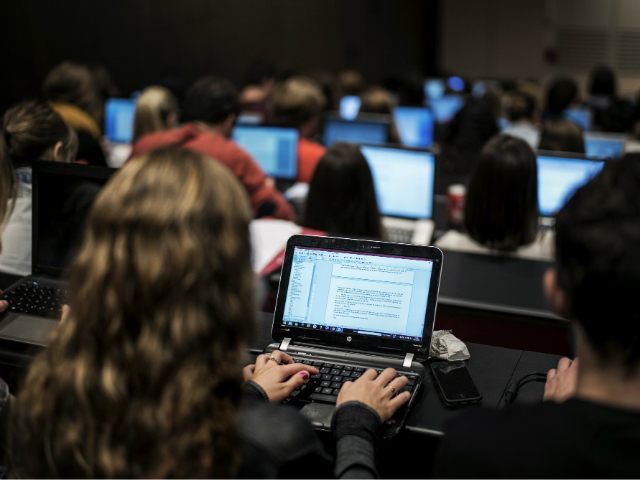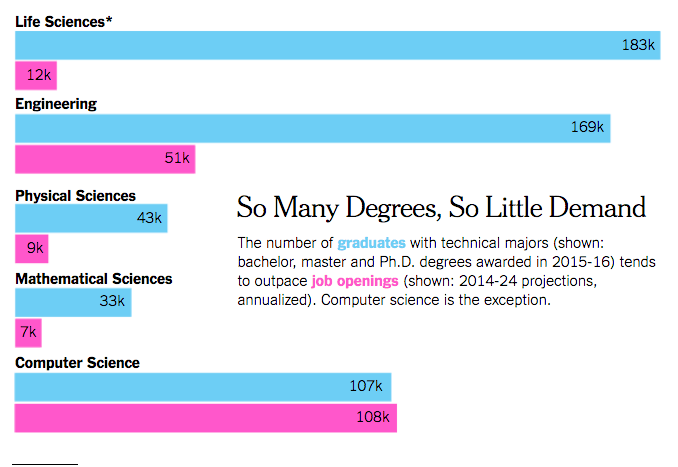The pool of foreign workers in the United States is falling because fewer foreigners are enrolling at U.S. universities, according to a Bloomberg article that prompted many complaints by business and migration advocates.
“This chart should be setting off alarm bells!” said a tweet by Alex Stapp, the libertarian-minded director of technology policy at the Progressive Policy institute. “A collapse in foreign students coming to the U.S. is a disaster for long-run innovation and American hegemony.”
The number of foreigner registration at U.S. colleges is heading towards 150,000 for 202o, down from nearly 400,000 in 2019, according to a September 10 Bloomberg forecast, which is headlined, “Covid-19 Interrupts Flow of Foreign Students to U.S.”
“I really feel for the international students today,” said a tweet from immigration lawyer Ian Wagreich. “Back in the 90s and early 2000s so much U.S. innovation was driven by former Indian (& other) international students, and now they are stuck with extremely limited options for decades.”
“I think its great,” countered Kevin Lynn, founder of U.S. Tech Workers, which advocates against the Fortune 500’s use of visa workers.
The decline will open up new opportunities and jobs for American graduates, many of whom lose out to the foreigners who enroll in U.S. universities to get work permits.
Each year, more than 400,000 foreign graduates get work permits via the uncapped Curricular Practical Training (CPT) and the uncapped Optional Practical Training (OPT) programs.
The foreigners are hoping to get green cards, so they will work long hours at very low wages in distant locations, he said. This little-recognized Green Card Economy now includes roughly one million foreign workers, pushing many Americans off the career ladder, he said.
If the supply of foreign workers for the Green Card Economy shrinks in 2021, the Fortune 500 companies will have to hire more Americans via the normal labor market, he said. “It’s supply and demand,” he said.
Lynn’s perspective was echoed by tweeted responses to Stapp’s alarmed complaints:
Sorry Alec, I'm not feeling all that concerned for the 'profits' of our current collegiate system, which has become nothing more than a scam.
What I am concerned about is the inability of talented, hard-working American students to find decent-paying jobs in America.
— Lori (forced militant) (@MMOrpgPrincess) September 11, 2020
Tests show that U.S. students and graduates rank far above Chinese and Indian rivals, according to a Stanford University study, which was published by the National Academy of Sciences in 2019:
We find that seniors in the United States substantially outperform seniors in China, India, and Russia by 0.76–0.88 SDs and score comparably with seniors in elite institutions in these countries. Seniors in elite institutions in the United States further outperform seniors in elite institutions in China, India, and Russia by ∼0.85 SDs. The skills advantage of the United States is not because it has a large proportion of high-scoring international students.
Also, there is little evidence that there is a shortage of American graduates and much evidence that the supply of skilled American graduates exceeds the number of tech jobs.
However, many Fortune 500 CEOs prefer to use subcontracted foreign workers in the Green Card Economy because they are controllable and disposable and also because they cannot quit their jobs to launch a rival product.
The decline in foreign students is also good for American students who may want to do post-graduate degrees in U.S. universities, Lynn said. “Universities have not had to focus on recruiting American students because they’ve had a large pool of [high-paying] foreign students… those slots that could’ve gone to foreign students can go to Americans.”
The nation’s immigration system has other channels to welcome clever, production foreigners, he said. For example, the O-1 visa can be used by accomplished foreigners to land jobs in the United States, he said. “The O-1 visa is for the highly talented people we want, and we can get them in,” without the OPT and CPT programs, he said.
Also, the huge H-1B program keeps at least 600,000 foreign workers in the Green Card Economy, much to the disadvantage of Americans, he said. In June, President Donald Trump ordered a rewrite of the H-1B regulation so that companies cannot use the program to replace Americans.
The rewrite has not yet been published. Business groups are lobbying heavily to narrow the reform, one source told Breitbart News.
The loss of foreign customers will be painful for universities that are used to attracting high-paying foreign customers who are seeking work permits. The Bloomberg.com article says:
the fact that some colleges won’t be able to land as many affluent international students as they used to is maybe not the biggest deal in the world. And yes some institutions overdid it with recruiting from China in particular in the 2010s, bringing over so many students with such limited English-language ability that the usual benefits of international exchange didn’t entirely apply. But in general international students are a boon to the universities they attend and the communities around them. As an inhabitant of a neighborhood near Columbia University in New York that over the past five years has added several great Chinese restaurants and a Korean supermarket, I know they have enriched my life.
Advocates for migration usually ignore the huge distinction between the majority of medium-skilled foreign workers who displace Americans and the important but smaller inflow of clever people, sometimes called “superstars,” who develop new ideas and create new jobs.
For example, in a September interview by the American Enterprise Institute, Caleb Watney, the director of innovation policy at the Progressive Policy Institute, credited “international talent flows” for U.S. innovation, lumped together gig-workers and software-tester with PhDs working on artificial intelligence:
Yeah, so to my mind — and this is for the US economy specifically — number one is international talent flows. For a long, long time now, the United States has been the premier destination for international scientists, entrepreneurs, and technical practitioners, and if you have a good idea and you want to develop it, there’s really been no better place than the United States. You see that reflected in our international students. For example, computer science graduate students: 79 percent of them in the United States are international students, and that’s not because we’re kicking a bunch of Americans out of those programs. It’s because our higher education system is the best and brightest in the world, and that is attracting so many bright young minds from across the world that want to come here to study. Of course, they potentially hope to stay here long-term.
However, under pressure from Trump’s pro-American immigration policy, Watney said he is looking at how the federal government can increase the inflow of “superstars”:
We really don’t have a path forward for the most highly skilled computer scientists, engineers, and academic scientists to be able to come into the US. I’m currently working on a paper, actually, to potentially revamp the O-1 visa for immigrants of extraordinary ability. I think that’s been a latent tool that only a few thousand people get in, and we could really overhaul and make it a much better pathway.
But the lawyers who help import the foreign workers support the existing work permit programs.
“Hopefully, we will come back roaring strong next year,” tweeted immigration lawyer Leon Fresco, who is a backer of the S.386 giveaway bill. “This is one of the most important things the United States does.”
“We were once a beacon to the best and the brightest, which has been a strength of our nation,” said Wagreich. “It is unlikely that we will ever recover.”
Immigration shifts wealth from wages to stocks, from young to old, from central states to the coasts, from the many to the few.
Yes, migrants get huge relative gains in pay & civic life by moving into US.
But investors skim the $$ from the diversity#H1Bhttps://t.co/PVA75K3v9T— Neil Munro (@NeilMunroDC) August 21, 2020


COMMENTS
Please let us know if you're having issues with commenting.